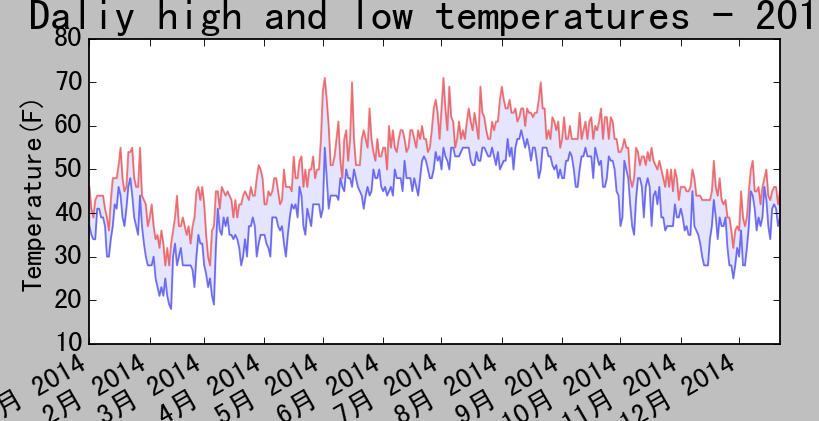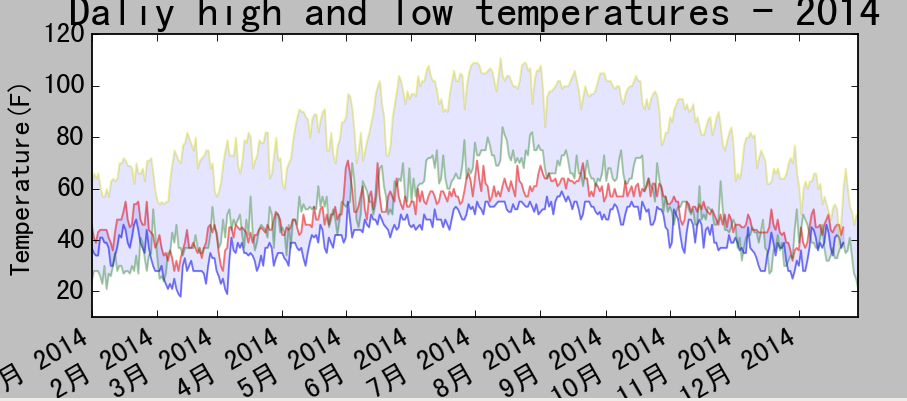将数据作为一系列以逗号分隔的值(CVS)写入文件,这些文件被称为CVS文件
绘制气温图表
1 import csv 2 import matplotlib.pyplot as plt 3 from datetime import datetime 4 5 6 filename = 'sitka_weather_2014.csv' 7 with open(filename) as f: 8 """调用方法csv.reader()创建一个阅读器对象,并存储在reader中""" 9 reader = csv.reader(f) 10 header_row = next(reader) 11 #print(header_row) 12 # for index, colum_header in enumerate(header_row): 13 # print(index, colum_header) 14 15 dates, highs, lows = [], [], [] 16 for row in reader: 17 #将字符串转化为日期对象 18 current_date = datetime.strptime(row[0], "%Y-%m-%d") 19 dates.append(current_date) 20 high = int(row[1]) 21 highs.append(high) 22 low = int(row[3]) 23 lows.append(low) 24 #print(highs) 25 #print(dates) 26 27 #根据数据绘制图形,alpha为透明度设置 28 fig = plt.figure(dpi=128, figsize=(10, 6)) 29 plt.plot(dates, highs, c='red', alpha=0.5) 30 plt.plot(dates, lows, c='blue', alpha=0.5) 31 plt.fill_between(dates, highs, lows, alpha=0.1)#给图表区域着色 32 #设置图形格式 33 plt.title("Daliy high and low temperatures - 2014", fontsize=24) 34 plt.xlabel('', fontsize=16) 35 #绘制倾斜的日期标签 36 fig.autofmt_xdate() 37 plt.ylabel("Temperature(F)", fontsize=16) 38 plt.tick_params(axis='both', which='major', labelsize=16) 39 40 plt.show()
Figure:

错误检查:
1 import csv 2 import matplotlib.pyplot as plt 3 from datetime import datetime 4 5 6 filename = 'death_valley_2014.csv' 7 with open(filename) as f: 8 """调用方法csv.reader()创建一个阅读器对象,并存储在reader中""" 9 reader = csv.reader(f) 10 header_row = next(reader) 11 #print(header_row) 12 # for index, colum_header in enumerate(header_row): 13 # print(index, colum_header) 14 15 dates, highs, lows = [], [], [] 16 for row in reader: 17 try: 18 #将字符串转化为日期对象 19 current_date = datetime.strptime(row[0], "%Y-%m-%d") 20 high = int(row[1]) 21 low = int(row[3]) 22 except ValueError: 23 print(current_date, "missing data") 24 else: 25 dates.append(current_date) 26 highs.append(high) 27 lows.append(low) 28 #print(highs) 29 #print(dates) 30 31 #根据数据绘制图形,alpha为透明度设置 32 fig = plt.figure(dpi=128, figsize=(10, 6)) 33 plt.plot(dates, highs, c='red', alpha=0.5) 34 plt.plot(dates, lows, c='blue', alpha=0.5) 35 plt.fill_between(dates, highs, lows, alpha=0.1)#给图表区域着色 36 #设置图形格式 37 plt.title("Daliy high and low temperatures - 2014", fontsize=24) 38 plt.xlabel('', fontsize=16) 39 #绘制倾斜的日期标签 40 fig.autofmt_xdate() 41 plt.ylabel("Temperature(F)", fontsize=16) 42 plt.tick_params(axis='both', which='major', labelsize=16) 43 44 plt.show()
Figure:

用try-except-else 来处理数据缺失的问题。
将2个数据集画在同一个图表上:
1 import csv 2 import matplotlib.pyplot as plt 3 from datetime import datetime 4 5 6 filename_1 = 'sitka_weather_2014.csv' 7 filename_2 = 'death_valley_2014.csv' 8 with open(filename_1) as f1, open(filename_2) as f2: 9 """调用方法csv.reader()创建一个阅读器对象,并存储在reader中""" 10 reader_1 = csv.reader(f1) 11 header_row_1 = next(reader_1) 12 reader_2 = csv.reader(f2) 13 header_row_2 = next(reader_2) 14 #print(header_row) 15 # for index, colum_header in enumerate(header_row): 16 # print(index, colum_header) 17 18 dates_1, dates_2, highs_1, lows_1, highs_2, lows_2 = [], [], [], [], [], [] 19 for row in reader_1: 20 try: 21 #将字符串转化为日期对象 22 current_date_1 = datetime.strptime(row[0], "%Y-%m-%d") 23 high_1 = int(row[1]) 24 low_1 = int(row[3]) 25 except ValueError: 26 print(current_date_1, "missing data") 27 else: 28 dates_1.append(current_date_1) 29 highs_1.append(high_1) 30 lows_1.append(low_1) 31 32 for row in reader_2: 33 try: 34 #将字符串转化为日期对象 35 current_date_2 = datetime.strptime(row[0], "%Y-%m-%d") 36 high_2 = int(row[1]) 37 low_2 = int(row[3]) 38 except ValueError: 39 print("missing data") 40 # high_2 = highs_2[-1] 41 # low_2 = lows_2[-1] 42 else: 43 dates_2.append(current_date_2) 44 highs_2.append(high_2) 45 lows_2.append(low_2) 46 #print(highs) 47 #print(dates) 48 49 #根据数据绘制图形,alpha为透明度设置 50 fig = plt.figure(dpi=128, figsize=(10, 6)) 51 plt.plot(dates_1, highs_1, c='red', alpha=0.5) 52 plt.plot(dates_1, lows_1, c='blue', alpha=0.5) 53 plt.fill_between(dates_1, highs_1, lows_1, alpha=0.1)#给图表区域着色 54 plt.plot(dates_2, highs_2, c='yellow', alpha=0.5) 55 plt.plot(dates_2, lows_2, c='green', alpha=0.5) 56 plt.fill_between(dates_2, highs_2, lows_2, alpha=0.1) # 给图表区域着色 57 #设置图形格式 58 plt.title("The contrast of two places'temperatures-2014", fontsize=24) 59 plt.xlabel('', fontsize=16) 60 #绘制倾斜的日期标签 61 fig.autofmt_xdate() 62 plt.ylabel("Temperature(F)", fontsize=16) 63 plt.tick_params(axis='both', which='major', labelsize=16) 64 65 plt.ylim([10, 120])#给y轴设置上下限 66 plt.show()
这样代码过于重复,我们可以创建一个提取天气信息的函数
1 import csv 2 import matplotlib.pyplot as plt 3 from datetime import datetime 4 5 6 def get_weather_data(filename, dates, highs, lows): 7 with open(filename) as f: 8 """调用方法csv.reader()创建一个阅读器对象,并存储在reader中""" 9 reader = csv.reader(f) 10 header_row = next(reader) 11 #print(header_row) 12 # for index, colum_header in enumerate(header_row): 13 # print(index, colum_header) 14 15 #dates, highs, lows = [], [], [] 16 for row in reader: 17 try: 18 #将字符串转化为日期对象 19 current_date = datetime.strptime(row[0], "%Y-%m-%d") 20 high = int(row[1]) 21 low = int(row[3]) 22 except ValueError: 23 print(current_date, "missing data") 24 else: 25 dates.append(current_date) 26 highs.append(high) 27 lows.append(low) 28 29 30 filename_1 = 'sitka_weather_2014.csv' 31 dates, highs, lows = [], [], [] 32 get_weather_data(filename_1, dates, highs, lows) 33 #根据数据绘制图形,alpha为透明度设置 34 fig = plt.figure(dpi=128, figsize=(10, 6))#创建一个窗口 35 plt.plot(dates, highs, c='red', alpha=0.5) 36 plt.plot(dates, lows, c='blue', alpha=0.5) 37 plt.fill_between(dates, highs, lows, alpha=0.1)#给图表区域着色 38 39 filename_2 = 'death_valley_2014.csv' 40 dates, highs, lows = [], [], [] 41 get_weather_data(filename_2, dates, highs, lows) 42 #根据数据绘制图形,alpha为透明度设置 43 #fig = plt.figure(dpi=128, figsize=(10, 6)),不要再次创建一个新窗口 44 plt.plot(dates, highs, c='yellow', alpha=0.3) 45 plt.plot(dates, lows, c='green', alpha=0.3) 46 plt.fill_between(dates, highs, lows, alpha=0.1)#给图表区域着色 47 48 49 #设置图形格式 50 plt.title("Daliy high and low temperatures - 2014", fontsize=24) 51 plt.xlabel('', fontsize=16) 52 #绘制倾斜的日期标签 53 fig.autofmt_xdate() 54 plt.ylabel("Temperature(F)", fontsize=16) 55 plt.tick_params(axis='both', which='major', labelsize=16) 56 57 plt.ylim([10, 120]) 58 plt.show()
Figure:






















 2032
2032











 被折叠的 条评论
为什么被折叠?
被折叠的 条评论
为什么被折叠?








